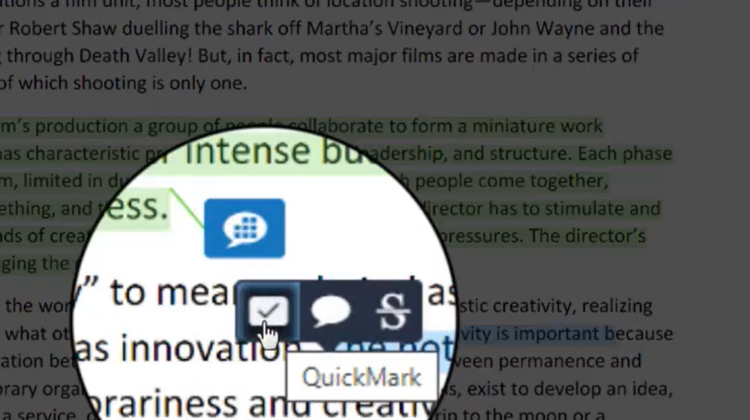Case Study: Utilising Turnitin Marking and Feedback Tools

Why was this needed?
Providing feedback for our students is an incredibly important part of the assessment process. However, it can be logistically challenging to offer personalised and detailed feedback at scale for written formative and summative assessment. Furthermore, when multiple markers are working across the same assignment it can be hard to ensure consistency is being reached.
How did they do it?
Martin Simmons, Senior Lecturer in Civil Engineering, teaches across units with large student cohorts. He utilises the Turnitin tool QuickMarks and Turnitin rubrics to speed up the process of giving students feedback, without compromising the level of personalised detail that each student receives. Martin also utilises these tools when working alongside Graduate Teaching Assistant (GTA) colleagues to support and guide their development as markers.
QuickMarks allows markers to replicate common feedback across scripts, this is most valuable for those comments that are likely to be repeated several times even within the same paper. QuickMarks uses a library of comments and as such it is feasible for these to be shared across markers marking the same assignment. This is especially valuable for less experienced markers who may wish to use the comments of more experienced markers as the basis for their feedback. When using a QuickMark comment there is the option to add more detail, thus making it more specific to the script being marked. Of course, there is still the option to add traditional text-based comments alongside QuickMark comments.
Martin uses Turnitin rubrics to structure a simplified rubric explicitly aligned with those Intended Learning Objectives that are being assessed. This rubric can be shared with the student prior to starting their assessment and can be reshared once it has been used to mark their assessment, allowing full transparency about how their mark has been reached. This rubric can be set by Martin, allowing a greater degree of accountability with other markers marking to the same criteria. Creating a rubric takes a considerable initial input of time and experience but will subsequently make the marking process much more efficient and can be utilised for several iterations of the same assessment. Both tools allow less experienced markers to develop their marking skills, through utilising the same library or rubric as set by the lead marker. Further, Martin runs internal verification checks to ensure that markers are using the tools in a consistent way. This facilitates personalised feedback to the markers themselves, which can be used as evidence of good teaching practice (for example, when creating an application for a HEA Teaching Fellowship).
What do students think?
“I found the feedback very useful and it gave me an excellent visual representation of how to improve in future assignments by specifying exactly where the change needed to occur. It enables me to understand the comments immediately and be able to act on them. I find this much more useful.
Looking back at Structures 2, this has been one of the few units where I was given a marking rubric not only after the mark was out, but also when the coursework was issued. I found this very useful as it was very easy to understand what is expected from me. One of the biggest challenges I’ve been facing since starting Uni is understanding every detail of what I need to do before starting to complete the assignment. This results in extra time spent on understanding the assignment rather than producing the required work.”
Both QuickMarks and rubrics have been well received by the students. QuickMarks allows for a high level of detailed and targeted feedback while the rubric allows for a much greater level of transparency with students understanding the marking criteria being used to assess them. One student described having a better ‘visual representation of how to improve in future assignments’ with using the rubric. Martin believes that use of these tools has reduced the number of students who query the grade they are given within these courses.
What do GTA’s think?
“Rubrics use make marking quite easier for me. The predefined grades in the rubric for a particular answer make the marking balanced and unbiased. Quick Marks makes marking quicker and easy. As most of the students commit the same mistake often and hence using quick marks makes it easier to point out.”
“It is a great interaction between you and me, based on which I am able to quickly realise if my marking standard is reasonable or not. It has provided a direction for the improvement of my work as an assessor.”
Both QuickMarks and Turnitin rubrics enable a much higher level of consistency with marking, with one GTA referring to it being like they ‘have a partner while marking’. The internal verification checks that Martin does underpins marking consistency through routinely checking a selection of marked scripts. This process also offers an extremely valuable professional development opportunity for GTA colleagues. They receive feedback on their marking and advice on ways they might improve.
Impact in FSE
The use of QuickMarks and Turnitin rubrics requires an initial investment of time and energy but can be a rewarding and effective experience for lead marker, GTA markers and students alike. The tools help bring a greater level of transparency and consistency into the marking process. Martin’s work with GTA colleagues has also shown the potential value of using this approach to develop marking skills across our Faculty; with less experienced markers receiving much-valued feedback in their marking.
Check out Turnitin Frequently Asked Questions for links to guidance and resources.
Get in touch
If you would be interested in exploring how you can use these tools in your own course or you have a similarly innovative feedback and assessment method to share with colleagues, please do get in touch.


